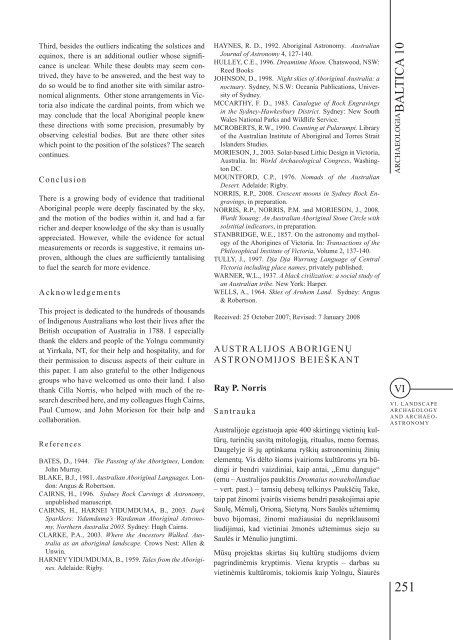BALTICA10
BALTICA10
BALTICA10
You also want an ePaper? Increase the reach of your titles
YUMPU automatically turns print PDFs into web optimized ePapers that Google loves.
Third, besides the outliers indicating the solstices and<br />
equinox, there is an additional outlier whose significance<br />
is unclear. While these doubts may seem contrived,<br />
they have to be answered, and the best way to<br />
do so would be to find another site with similar astronomical<br />
alignments. Other stone arrangements in Victoria<br />
also indicate the cardinal points, from which we<br />
may conclude that the local Aboriginal people knew<br />
these directions with some precision, presumably by<br />
observing celestial bodies. But are there other sites<br />
which point to the position of the solstices? The search<br />
continues.<br />
Conclusion<br />
There is a growing body of evidence that traditional<br />
Aboriginal people were deeply fascinated by the sky,<br />
and the motion of the bodies within it, and had a far<br />
richer and deeper knowledge of the sky than is usually<br />
appreciated. However, while the evidence for actual<br />
measurements or records is suggestive, it remains unproven,<br />
although the clues are sufficiently tantalising<br />
to fuel the search for more evidence.<br />
Acknowledgements<br />
This project is dedicated to the hundreds of thousands<br />
of Indigenous Australians who lost their lives after the<br />
British occupation of Australia in 1788. I especially<br />
thank the elders and people of the Yolngu community<br />
at Yirrkala, NT, for their help and hospitality, and for<br />
their permission to discuss aspects of their culture in<br />
this paper. I am also grateful to the other Indigenous<br />
groups who have welcomed us onto their land. I also<br />
thank Cilla Norris, who helped with much of the research<br />
described here, and my colleagues Hugh Cairns,<br />
Paul Curnow, and John Morieson for their help and<br />
collaboration.<br />
References<br />
BATES, D., 1944. The Passing of the Aborigines, London:<br />
John Murray.<br />
BLAKE, B.J., 1981. Australian Aboriginal Languages. London:<br />
Angus & Robertson.<br />
CAIRNS, H., 1996. Sydney Rock Carvings & Astronomy,<br />
unpublished manuscript.<br />
CAIRNS, H., HARNEI YIDUMDUMA, B., 2003. Dark<br />
Sparklers: Yidumduma’s Wardaman Aboriginal Astronomy,<br />
Northern Australia 2003. Sydney: Hugh Cairns.<br />
CLARKE, P.A., 2003. Where the Ancestors Walked. Australia<br />
as an aboriginal landscape. Crows Nest: Allen &<br />
Unwin.<br />
HARNEY YIDUMDUMA, B., 1959. Tales from the Aborigines.<br />
Adelaide: Rigby.<br />
HAYNES, R. D., 1992. Aboriginal Astronomy. Australian<br />
Journal of Astronomy 4, 127-140.<br />
HULLEY, C.E., 1996. Dreamtime Moon. Chatswood, NSW:<br />
Reed Books<br />
JOHNSON, D., 1998. Night skies of Aboriginal Australia: a<br />
noctuary. Sydney, N.S.W: Oceania Publications, University<br />
of Sydney.<br />
MCCARTHY, F. D., 1983. Catalogue of Rock Engravings<br />
in the Sydney-Hawkesbury District. Sydney: New South<br />
Wales National Parks and Wildlife Service.<br />
MCROBERTS, R.W., 1990. Counting at Pularumpi. Library<br />
of the Australian Institute of Aboriginal and Torres Strait<br />
Islanders Studies.<br />
MORIESON, J., 2003. Solar-based Lithic Design in Victoria,<br />
Australia. In: World Archaeological Congress, Washington<br />
DC.<br />
MOUNTFORD, C.P., 1976. Nomads of the Australian<br />
Desert. Adelaide: Rigby.<br />
NORRIS, R.P., 2008. Crescent moons in Sydney Rock Engravings,<br />
in preparation.<br />
NORRIS, R.P., NORRIS, P.M. and MORIESON, J., 2008.<br />
Wurdi Youang: An Australian Aboriginal Stone Circle with<br />
solstitial indicators, in preparation.<br />
STANBRIDGE, W.E., 1857. On the astronomy and mythology<br />
of the Aborigines of Victoria. In: Transactions of the<br />
Philosophical Institute of Victoria, Volume 2, 137-140.<br />
TULLY, J., 1997. Dja Dja Wurrung Language of Central<br />
Victoria including place names, privately published.<br />
WARNER, W.L., 1937. A black civilization: a social study of<br />
an Australian tribe. New York: Harper.<br />
WELLS, A., 1964. Skies of Arnhem Land. Sydney: Angus<br />
& Robertson.<br />
Received: 25 October 2007; Revised: 7 January 2008<br />
AUSTRALIJOS ABORIGENŲ<br />
ASTRONOMIJOS BEIEŠKANT<br />
Ray P. Norris<br />
Santrauka<br />
Australijoje egzistuoja apie 400 skirtingų vietinių kultūrų,<br />
turinčių savitą mitologiją, ritualus, meno formas.<br />
Daugelyje iš jų aptinkama ryškių astronominių žinių<br />
elementų. Vis dėlto šioms įvairioms kultūroms yra būdingi<br />
ir bendri vaizdiniai, kaip antai, „Emu danguje“<br />
(emu – Australijos paukštis Dromaius novaehollandiae<br />
– vert. past.) – tamsių debesų telkinys Paukščių Take,<br />
taip pat žinomi įvairūs visiems bendri pasakojimai apie<br />
Saulę, Mėnulį, Orioną, Sietyną. Nors Saulės užtemimų<br />
buvo bijomasi, žinomi mažiausiai du nepriklausomi<br />
liudijimai, kad vietiniai žmonės užtemimus siejo su<br />
Saulės ir Mėnulio jungtimi.<br />
Mūsų projektas skirtas šių kultūrų studijoms dviem<br />
pagrindinėmis kryptimis. Viena kryptis – darbas su<br />
vietinėmis kultūromis, tokiomis kaip Yolngu, Šiaurės<br />
ARCHAEOLOGIA BALTICA 10<br />
VI<br />
VI. LANDSCAPE<br />
ARCHAEOLOGY<br />
AND ARCHAEO-<br />
ASTRONOMY<br />
251
















